Road movie - Genres
Characteristics of the road-movie
The term "road-movie" refers to a fictional genre defined by the motif of a journey in which the protagonists travel over a long distance, typically in some form of transport, usually motorised. Unlike in many other films, the trip is not a secondary thematic element, but the main focus, and it is also linked to the motif of discovery of landscapes and various locations, which can work as a socio-critical, cultural or historical portrayal of the country where the action takes place. Other characteristic themes include an emphasis on motor culture and the fetishisation of cars and motorbikes, freedom and liberty, and a form of rebellion and self-discovery. The protagonists of road-movies embark on journeys for a variety of reasons, and their motivation is not necessarily to reach a particular destination. Commonly, for example, they are defiant and frustrated individuals, alienated from the rest of society, whose behaviour and actions clearly define them against the world of established conservative social norms. Road-movies, therefore, usually focus more on depicting their inner conflicts, feelings and the changes that occur during their journey than on the surrounding plot. Not only as a result of this, the narrative of most road-movies has a meandering structure based on a gradual layering of interconnected episodic stories.
This genre is most often associated with American culture and the aesthetics of American cars, highways, petrol stations, restaurants and diners, motels, and the endlessly stretching landscape of roads and natural scenery that highlight the motif of detachment from society and the conventions of the civilised world. These motifs became iconic especially in the second half of the 1960s, when the road-movie genre was born as a separate category. However, films about heroes on the road, themed around travel and means of transport, existed already long before that. Moreover, the road-movie is commonly mixed with other genres, most often with dramas, comedies, westerns, thrillers and action, crime or romantic films. It can also include various sub-genres, such as biker films, films about criminals (often married or loving couples) fleeing the law, or other films fulfilling certain key specifics of the genre, telling the story of individuals taking long hikes across the country.
Early elements of the road-movie in cinema
The interest in capturing different kinds of travel or means of transport in action has accompanied cinema since its inception, because, as a moving image, film was based on a fascination with movement. Short films such as The Arrival of a Train (1895) or How It Feels to Be Run Over (1900), which ended with a moving carriage crashing into the camera, already relied on this fascination. These trivial themes were later complemented by simple plots – for example, the four-minute film A Romance of the Rail (1903) dealt not only with a train ride but also with the story of a couple in love who get married during their journey. In later decades, the motif of travel was often associated especially with westerns, in which, horses and stagecoaches featured prominently in addition to trains. Among the westerns dealing largely with travelling we can mention The Covered Wagon (1923) or The Big Trail (1930).
The first proper prototypes of road-movies, however, did not begin to emerge until the 1930s, for example in Frank Capra's five-Oscar-winning romantic comedy It Happened One Night (1934), whose protagonist, on the run from her millionaire father and accompanied by a lowly journalist, meets a group of ordinary people struggling with the Depression during a bus journey, and Fritz Lang's crime-drama You Only Live Once (1937), which told the story of young lovers on the run, struggling with false accusations. For example, Richard Thorp's The Adventures of Huckleberry Finn (1939) was an adventure film with a strong theme of wandering, focused on the fate of two heroes, a boy running away from his father and a black slave escaping from captivity. John Ford's Stagecoach (1939), a western about a group of diverse characters travelling in a stagecoach through dangerous Apache territory, was nominated for seven Oscars, and Victor Fleming's The Wizard of Oz (1939), about the adventures of a young girl as she travels through a fantasy land where she was swept away by a tornado, took in two of its six nominations.
It Happened One Night (1934)
Photo © Columbia Pictures Corporation
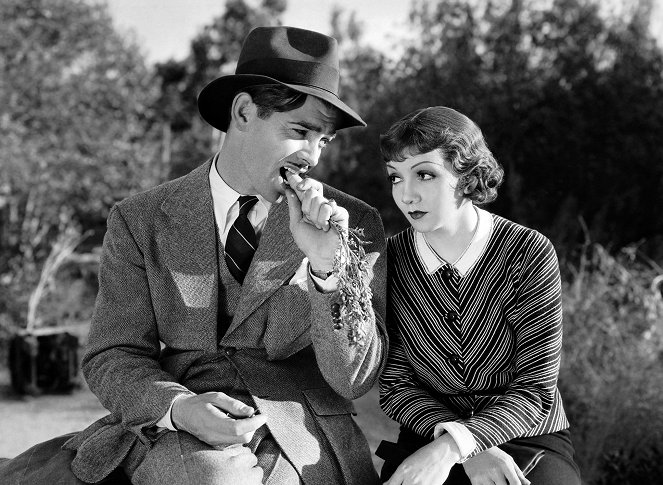
Forerunners of the road-movie in the 1940s and 50s
In the 1940s, films set on road trips included, among others, John Ford's two Oscar-winning The Grapes of Wrath (1940), about a natural disaster-stricken family of farmers forced to seek their fortune in the West, and Preston Sturges's satirical Sullivan's Travels (1941), in which the film director himself went in disguise as a tramp to seek inspiration among the common folk, and the seven-part series of musical travel comedies begun with Road to Singapore (1940) and Road to Zanzibar (1941). Travelling was also a major element in several film-noirs, in particular, They Drive by Night (1940), Detour (1945), Desperate (1947), They Live by Night (1948), Gun Crazy (1950), The Hitch-Hiker (1953), Plunder Road (1957) and Thunder Road (1958). The post-war era, moreover, marked a new chapter in motoring films thanks to the burgeoning automotive industry and the emphasis on the younger generation. A typical representative in this respect was The Wild One (1953), about the leader of a large motorcycle gang who falls in love with the daughter of a hostile policeman.
Other influential forerunners of the road-movie were The Searchers (1956), a western by John Ford about a tough officer on a quest to find his niece kidnapped by Indians, Stanley Kramer's nine-Oscar-nominated The Defiant Ones (1958), depicting the fate of two escaped convicts forced to overcome racial prejudice in their flight, and Alfred Hitchcock's thriller North by Northwest (1959), whose hero is a victim of secret service spying while travelling to various American locations. There were also several comedies with a travel theme, such as The Long, Long Trailer (1953), about a husband and wife living in a caravan, and Bus Stop (1956), about a young singer's tour. A major influence on later films and on the road-movie genre as a whole was the socially critical novel “On the Road” by Jack Kerouac. Published in 1957, it presented the road and travel across the United States as synonymous with freedom, liberty, rebellious defiance and the discovery of new places and new people.
Sullivan's Travels (1941)
Photo © Paramount Pictures

The beginning of the golden era of road-movies in the 1960s
The first half of the 1960s saw films such as It's a Mad, Mad, Mad, Mad World (1963), a crime comedy about a 200-mile treasure hunt nominated for six Academy Awards, and the five-Oscar-nominated The Great Race (1965). From the opposite side of the spectrum we can mention, for example, the trashy exploitation films Motor Psycho (1965) and Faster, Pussycat! Kill! Kill! (1965). The turning point, however, came in the second half of that decade, when the collapse of the studio system opened the door to the New Hollywood era, defined by the emergence of a new generation of filmmakers who reinvigorated cinema with a burst of fresh creative energy and a passion for the artistic values of film. The road-movie became a genre in its own right, with two breakthrough works: Arthur Penn's ten Oscar-nominated Bonnie and Clyde (1967), inspired by a real-life couple of lovers and criminals who became celebrities and symbols of the struggle against the system during the Depression, and Dennis Hopper's two Oscar-nominated Easy Rider (1969), which, thanks to the freewheeling, drug-and-rock-fuelled wanderings of a pair of rebellious bikers, went down in history as a cornerstone of the road-movie genre and its most typical representative. In contrast, The Wild Angels (1966) and Hells Angels on Wheels (1967) were much less prominent representatives of motorcycle films.
While Bonnie and Clyde primarily followed on the tradition of the gangster film and formed an imaginary boundary between classical and New Hollywood, Easy Rider drew primarily from the independent scene, the social atmosphere of the time and European modernism. Both films enriched cinema with modern creative approaches, both stylistically and ideologically, and foreshadowed the development of American cinema for decades to come. Just as their heroes defiantly distanced themselves from the conventions of society, the filmmakers defined themselves against the established rules of Hollywood studios and filmmaking practices. The road-movie genre also benefited from technological developments that made it possible to use smaller cameras, mount them directly on vehicles and easily achieve unique shots that did not require large crews or studio resources. Filming on location became widespread, music became a significant element of road-movies, and the tendency to revise popular genres and their templates was also an important aspect. The road-movies of the late 1960s include films such as Francis Ford Coppola's The Rain People (1969), in which the pregnant heroine tries to escape the weight of her own responsibility with a secret car ride away from her husband, and Stanley Donen's British romantic film Two for the Road (1967).
Easy Rider (1969)
Photo © Columbia Pictures Corporation
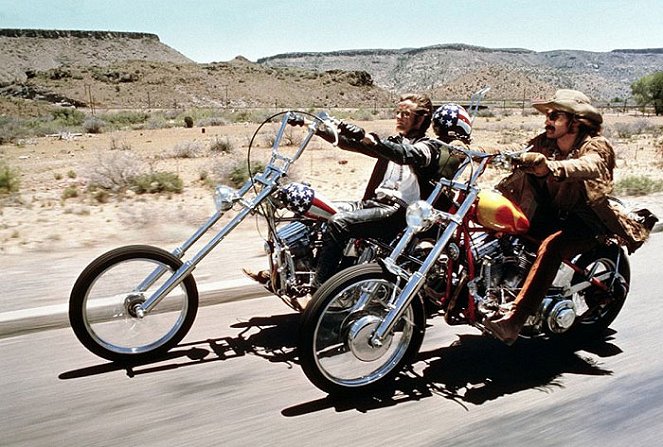
The boom of road-movies in the 1970s
The road-movie genre enjoyed a significant blossoming in the 1970s, when it essentially took the place of the classic western, which had been in decline since the previous decade. Road-movies were embraced by many New Hollywood directors, such as Monte Hellman (Two-Lane Blacktop, 1971), Richard C. Sarafian (1971's Vanishing Point), Hal Ashby (1973's The Last Detail), Jerry Schatzberg (1973's Scarecrow), Terrence Malick (1973's Badlands), Sam Peckinpah (1974's Bring Me the Head of Alfredo Garcia, 1978's Convoy), and Martin Scorsese (1972's Boxcar Bertha, 1974's Alice Doesn't Live Here Anymore). One of the most prominent filmmakers at the time was the up-and-coming Steven Spielberg, who ventured into the road-movie genre with his short Amblin' (1968) and the television film Duel (1971), and then made his feature film debut in cinemas with The Sugarland Express (1974), about a couple escaping from the constant persecution of the police, motivated by the desire to save their son from being adopted by strangers. Director William Friedkin made Sorcerer (1977), a remake of a famous French thriller about truck drivers hired to transport a dangerous load of nitroglycerine through the Latin American jungle.
Bob Rafelson's Five Easy Pieces (1970) was up for four Oscars, Peter Bogdanovich's Paper Moon (1973) was nominated for the same number of statuettes with its comedic tale set in the 1930s about a crooked Bible salesman accompanied on his travels by an orphaned nine-year-old girl, and Harry and Tonto (1974), about a septuagenarian who travels across America with his cat, received one Oscar. Road-movies took on many forms and were combined with a variety of genres, such as racing action films (Death Race 2000, 1975, Cannonball and The Gumball Rally, 1976), gangster films (Thieves Like Us, 1974), crime comedies (Thunderbolt and Lightfoot, 1974), redneck comedies (Smokey and the Bandit, 1977), and family puppet films (The Muppet Movie, 1979).
Scarecrow (1973)
Photo © Warner Bros. Pictures
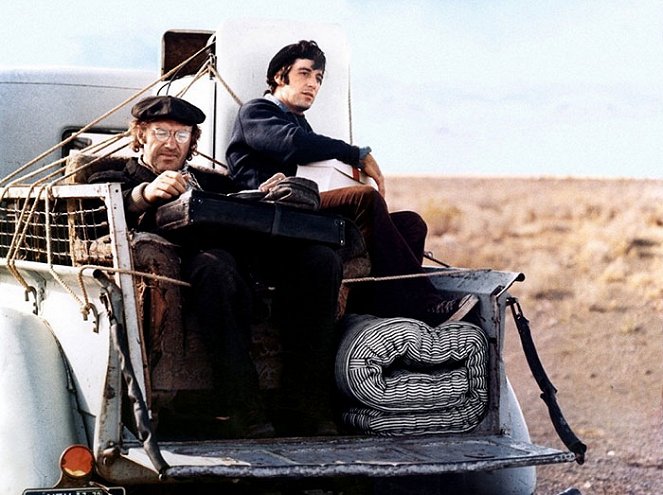
Classic and unconventional road-movies in the 1980s
One of the most distinctive road-movies of the 1980s was Barry Levinson's four-Oscar-winning Rain Man (1988), the journey of a young scheming entrepreneur and his autistic older brother, who didn’t know about each other until then. Clint Eastwood's Honkytonk Man (1982) focused on a drifter travelling across America accompanied by his nephew. Other films that included attributes of the classic road-movie include comedies such as The Cannonball Run (1981) and its sequel Cannonball Run II (1984), about an illegal race across the United States, Vacation (1983), whose protagonists are members of a family embarking on a journey to a remote amusement park, and Planes, Trains & Automobiles (1987), in which fate forces a pair of travellers to spend several days together in different means of transport. In the comedy Bustin' Loose (1981), a convicted criminal is forced to transport a group of children and their governess to another town in an old bus, while the comedy Fandango (1985) dealt with the story of five recent college graduates who decide to spend one last weekend traveling together before some of them enlist in Vietnam, and in the bitterly critical comedy Lost in America (1985), a married couple begins to lose their illusions after deciding to put their current existence behind them and spend the rest of their lives in a camper van. Tim Burton's directorial debut Pee-wee's Big Adventure (1985) and Rob Reiner's romantic comedy The Sure Thing (1985) also won many fans.
Other films, however, took a somewhat more radical and innovative approach to aspects of the genre, most notably Australia's Mad Max 2: The Road Warrior by George Miller (1982), whose action-packed story is set in a post-apocalyptic world of motorcycle and other motorized gangs fighting over fuel supplies. John Landis's The Blues Brothers (1980) combined a road-movie with an action-comedy musical, Kathryn Bigelow's Near Dark (1987) merged a road-movie with a western vampire horror, and Robert Harmon's slasher The Hitcher (1986) worked with suspense. Non-traditional road-movies also include Jonathan Demme's love thriller comedy Something Wild (1986), Walter Hill's musical drama Crossroads (1986), Martin Brest's crime comedy Midnight Run (1988), and the British Indian odyssey Powwow Highway (1989). There were other prominent auteur filmmakers who contributed to the road-movie genre, such as Jim Jarmusch with Stranger Than Paradise, (1984) and Gus Van Sant, whose crime-drama Drugstore Cowboy (1989) featured a drug addict with the police on his heels travelling from town to town with his wife and other people, robbing pharmacies.
Planes, Trains & Automobiles (1987)
Photo © Paramount Pictures
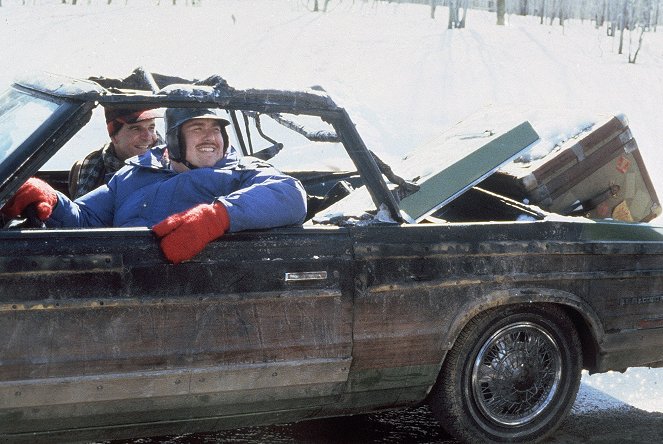
European road-movies to the late 1980s
Although the history of the road-movie is primarily linked to the United States, the techniques and attributes of the genre have been successfully adopted by several European filmmakers, who worked with them within the confines of European realities and enriched them with their own stylistic elements, and some of their works, especially from the 1950s and 60s, became models and inspirations for many American directors, typically those from the New Hollywood era – for example, the aforementioned Bonnie and Clyde and Easy Rider drew on the French New Wave. The most influential director in this respect was Jean-Luc Godard and his film Breathless (1960), about the rebellion against the system of a charming French delinquent and his American lover, yearning for freedom and liberty, as well as his later road-movies Crazy Pete (1965) and Weekend (1967). Another French production worth mention is The Wages of Fear by Henri-Georges Clouzot (1953), which was the basis for the aforementioned American remake directed by William Friedkin. In later decades, Bertrand Blier’s controversial Going Places (1974) and Agnès Varda’s Vagabond (1985), about a young homeless woman, also became popular road-movies in France.
Existential wanderings in various parts of Europe became a theme in Italy, too, as evidenced by Federico Fellini's The Road (1954) and Roberto Rossellini's Voyage in Italy (1954), as well as in Sweden, with, for example, Ingmar Bergman's Wild Strawberries (1957), about the wanderings of an aging professor who picks up various hitchhikers along the way. In West Germany, Wim Wenders became an icon of the road-movie genre in the 1970s, directing a trilogy consisting of Alice in the Cities (1974), The Wrong Movement (1975) and Kings of the Road (1976), and later achieving international success with the award-winning Paris, Texas (1984). Also worth mention is the Yugoslavian tragicomic film by Slobodan Šijan Who's Singin' Over There? (1980), about a strange group of people travelling by bus to Belgrade. In Greece, Theo Angelopoulos directed the co-production Landscape in the Mist (1988), depicting the fate of two siblings travelling from Greece to Germany in search of their alleged father, and Finnish director Aki Kaurismäki made the road-movie Leningrad Cowboys Go America (1989), about the journey of a fictional Russian music group to the USA.
The Wrong Movement (1975)
Photo © Reverse Angle Library GmbH

Revisionist and other road-movies of the 1990s
The early 1990s were still relatively prolific in terms of the road-movies, but their numbers began to decline over the decade in favour of other genres. Many of those films continued the effort to revise the established rules, while the approach to the main protagonists in particular changed compared to the previous decades. Until then, the heroes of road-movies were mostly men and heterosexual couples, but in Ridley Scott's Thelma & Louise (1991), nominated for six Academy Awards, for example, they were two emancipated women. Women on the road was also later explored in the comedy Boys on the Side (1995). In the drama The Living End (1992) the protagonists were two gay and HIV-positive men, in the Australian film The Adventures of Priscilla, Queen of the Desert (1994) the main characters were a group of drag queens, and To Wong Foo, Thanks for Everything! Julie Newmar (1995) also worked with transvestites, while Spike Lee's conversational film Get on the Bus (1996) told the story of disparate group of people made of black men who take a bus to the nation's capital for a peace protest march. Meanwhile, the road-movie Smoke Signals (1998) became the first film ever made and produced by Native-Americans to achieve international fame.
On the other hand, the theme of criminal lovers on the run from the law was revisited in Dominic Sena's California (1993), Tony Scott's True Romance (1993), and Oliver Stone's Natural Born Killers (1994), which thematised radical defiance against society. The road-movie genre was repeatedly revisited by directors such as David Lynch (1990's Wild at Heart and 1999's The Stright Story) and Gus Van Sant (1991's My Own Private Idaho and 1993's Even Cowgirls Get the Blues). In the comedy drama Coupe de Ville, three brothers set off on a cross-country journey to deliver their mother's dream Cadillac for her birthday, Josh and S.A.M. (1993) depicted the fate of two runaway brothers, and Clint Eastwood's A Perfect World (1993) featured a little boy as a main character. In Fear and Loathing in Las Vegas (1998), director Terry Gilliam enriched the main characters' travels across America with their experiments with drugs and hallucinations. The world of neo-noir films was explored by the similarly plotted Red Rock West (1993) and U Turn (1997). The road-movie genre also included comedies, such as Dumb & Dumber (1994), Flirting with Disaster (1996), Tumbleweeds (1999), and the animated Beavis and Butt-Head Do America (1996).
Dumb & Dumber (1994)
Photo © New Line Cinema
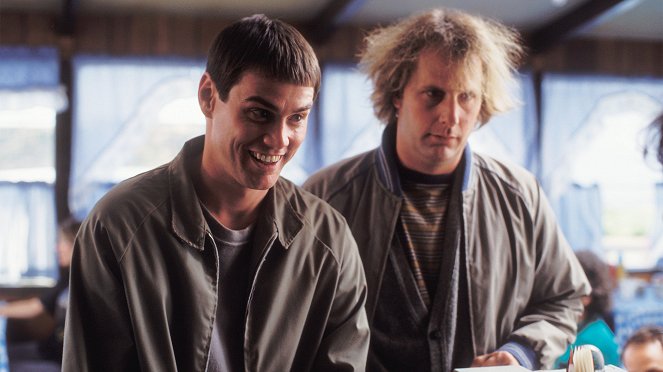
Road-movies after 2000
Road-movies have continued to evolve in the new millennium, and while they have certainly not become a popular genre, they have impressed all the more in many cases. Their production has largely developed in two directions: films that used the schematic framework of the road-movie as a basis for working with other genres broke through into the mainstream, while the more purely genre-based road-movies, emphasizing mainly social aspects, took hold mostly at film festivals and in many cases won awards. Two films worth highlighting in this respect are And Your Mother Too by Alfonso Cuarón (2001) or The Motorcycle Diaries by Walter Salles (2004), which also took part in the Oscar competition. The musical Almost Famous (2000), the story of a 15-year-old aspiring journalist accompanying a rock band on tour, was nominated for four Oscars, and Little Miss Sunshine (2006), about a quirky family travelling to a child beauty queen pageant, was up for the same number of statuettes. The road-movies About Schmidt (2002), Sideways (2004) and Nebraska (2013), directed by Alexander Payne, also garnered multiple Oscar nominations. Particularly successful were Peter Farrelly's Green Book (2018), whose story of the friendship between a black pianist and his white driver on a tour of the southern US states in the 1960s turned in three Oscars out of five, while Chloé Zhao's documentary-style Nomadland (2020) earned six nominations for its depiction of the fate of a woman living in a camper van and navigating modern nomadic communities. Other road-movies that have caused a stir at international festivals include, among others, Vincent Gallo's The Brown Bunny (2003), Duncan Tucker's Transamerica (2005), Walter Salles's On the Road (2012), Matt Ross's Captain Fantastic (2016) and Andrea Arnold's American Honey (2016).
In the mainstream sphere, the road-movie genre has merged mainly with comedy, for example, Jay and Silent Bob Strike Back (2001), Borat (2006), Wild Hogs (2007), We're the Millers (2013) and Identity Thief (2013), as well as the teen comedies Road Trip (2000), EuroTrip (2004) and Sex Drive (2008). There have also been a number of comedies inspired by road-movies from past decades, such as Due Date (2010) and Vacation (2015). Road-movies have also taken the form of thrillers (2001's Joy Ride, 2009's Dark Country), westerns (2007's 3:10 to Yuma, 2017's Hostiles), superhero sci-fi films (2017's Logan), and action films, most notably director George Miller's return to his own roots in the much-lauded and adrenaline-fuelled Mad Max: Fury Road (2015).
In Jim Jarmusch's comedy drama Broken Flowers (2005), the protagonist visits his ex-lovers in search of his son, In Sam Mendes's Away We Go (2009), a couple expecting a child search for a suitable place to settle permanently, and there have also been several films about escapes into the wild. Leaving civilisation as a form of rebellious defiance against consumer society was the subject of Into the Wild (2007), while in Wild (2014) the protagonist's walking pilgrimage across several states had a therapeutic function. Other films of note include the independent mumblecore comedy The Puffy Chair (2005) and the films Interstate 60 (2002), The Lucky Ones (2008) and Everybody's Fine (2009). Among the Asian productions that have made their mark in the history of road-movies we can mention the Japanese Kikujiro (1999), the Chinese Lost on Journey (2010) and Kaili Blues (2015), India’s You Don't Get Life a Second Time (2011), and South Korea’s A Taxi Driver (2017). Also worth mention are the Iranian films Taxi Tehran (2015) and Three Faces (2018), which their director Jafar Panahi shot from the interior of his own car.
Nomadland (2020)
Photo © Searchlight Pictures
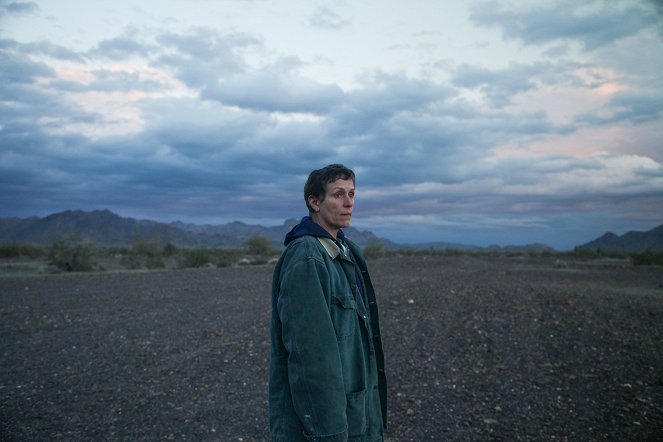
European road-movies since the 1990s
Many of the most prominent road-movies from European countries have addressed social issues through the example of their protagonists, gaining international fame at film festivals. They are often films dealing, for instance, with the world of immigrants crossing personal and geographical borders in order to find happiness and a better future for themselves, for instance the case with the Swedish-Danish drama Lilya 4-Ever (2002), the British film In This World (2002) and the French Eden Is West (2009). Other French films worth mention include Tango (1993), Transylvania (2006), Mammuth (2010) and Microbe & Gasoline (2015).
German director Wim Wenders continued his road-movie career with the multi-genre Until the End of the World (1991), the humorous Lisbon Story (1994) and the western Don't Come Knocking (2005), co-produced with the USA. Later, the road-movies Friendship! (2010), Goodbye Berlin (2016) and 25 km/h (2018) also found success in Germany. In Spain, on the other hand, the most frequent films combined the motif of travel with sexual comedy (Airbag, 1997) or were road-movies focused on social criticism and female protagonists (Fugitives, 2000), though the comedy-drama Living Is Easy with Eyes Closed (2013), set in Francoist Spain in the 1960s, is also worth mentioning. Czech cinema followed the genre traditions of road-movies, first in the 1990s with The Ride (1994) and later with Some Secrets (2002), ROMing (2007), Dolls (2007), Winter Flies (2018), Patrimony (2018) and Old-Timers (2019).
From Italy, the most successful road-movies have been Dear Diary (1993), Off to the Revolution by a 2CV (2001), The Leisure Seeker (2017) and Like Crazy (2016). Examples of Nordic road-movies include the Icelandic Children of Nature (1991) and Cold Fever (1995), the Finnish Take Care of Your Scarf, Tatiana (1994), the Norwegian Aberdeen (2000), the Danish Hush Little Baby (2009), the Danish-Swedish co-production Oldboys (2009), and the Norwegian co-production Before Snowfall (2013), about a Kurdish young man's journey to find his sister, who has tarnished his family's honour. The Red Colored Grey Truck (2004), set in the Balkans, spiced up the romantic plot with the motif of the incipient war in Yugoslavia, the cynical My Joy (2010) offered a cruel picture of the Russian character, the Slovak co-production tragicomic road-movie The Interpreter (2018) dealt with the reverberations of the traumas of World War II, and the Austrian socially critical drama Lillian (2019) followed a Russian immigrant's attempt to walk from New York back to her native country.
Filmmaniak
Best road movies
Rain Man (1988) |
Green Book (2018) |
Paris, Texas (1984) |
Wild Strawberries (1957) |
Who's Singin' Over There? (1980) |
Thelma & Louise (1991) |
Interstate 60 (2002) |
Paper Moon (1973) |
The Straight Story (1999) |
It Happened One Night (1934) |
| All the best road movies |